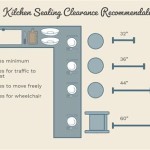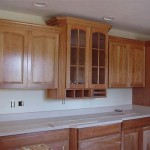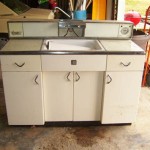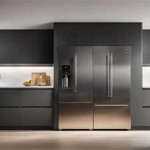```html
Kitchen Paint Ideas With Grey Cabinets: Creating a Harmonious Space
Grey cabinets have become a popular choice for modern kitchens due to their versatility and ability to complement a wide range of design styles. The neutral nature of grey allows for flexibility in selecting paint colors for the surrounding walls, opening up a plethora of possibilities to create a personalized and aesthetically pleasing kitchen environment. Choosing the right paint color, however, requires careful consideration of factors such as the shade of grey in the cabinets, the amount of natural light the kitchen receives, and the overall desired atmosphere.
The following exploration provides a comprehensive guide to identifying compatible paint colors for kitchens featuring grey cabinets. It will delve into specific color palettes, design considerations, and techniques for maximizing the visual appeal of this increasingly common kitchen design choice. The objective is to equip homeowners and designers with the knowledge necessary to make informed decisions about paint colors that will seamlessly integrate with their grey cabinets and enhance the overall beauty of their kitchens.
Understanding the Undertones of Grey Cabinets
Grey is not a monolithic color. It exists in a spectrum of shades, each possessing subtle undertones that influence the way it interacts with other colors. Identifying these undertones is crucial when selecting a complementary paint color. Grey cabinets can lean towards cool, warm, or neutral bases. Cool greys often display hints of blue, green, or violet, while warm greys possess yellow, beige, or brown undertones. Neutral greys are the most balanced, lacking any discernible undertones.
To determine the undertone of your grey cabinets, place a white piece of paper next to them. Compare the grey to the white. If the grey appears slightly blue or greenish in contrast to the stark white, it likely has cool undertones. Conversely, if the grey appears yellowish or beige, it possesses warm undertones. If the grey remains relatively unchanged next to the white, it is likely a neutral grey. Once the undertone is identified, you can select paint colors that either complement or contrast it, depending on the desired effect.
For example, if the cabinets have a cool grey undertone, pairing them with warm-toned paint colors such as creamy whites, soft yellows, or muted oranges can create a balanced and inviting atmosphere. Conversely, using cool-toned paint colors like pale blues, greens, or purples can amplify the coolness of the grey, resulting in a sophisticated and modern aesthetic. For neutral grey cabinets, the options are even more expansive, as they can effectively pair with both warm and cool colors, depending on the homeowner's preference.
Exploring Paint Color Palettes That Complement Grey Cabinets
Once the undertone of the grey cabinets is established, the next step is to explore specific paint color palettes that will create the desired ambiance in the kitchen. Several color families are known to work exceptionally well with grey cabinets, each offering a unique aesthetic.
Whites and Off-Whites: These classic choices provide a clean and timeless look that complements the neutrality of grey. Crisp whites offer a stark contrast, highlighting the architectural details of the cabinets and creating a bright and airy space. Off-whites, such as cream or ivory, offer a softer and warmer alternative, imbuing the kitchen with a sense of comfort and inviting character. When selecting a white or off-white paint, consider the undertones present in the grey cabinets. If the cabinets have cool undertones, choose a white with a hint of warmth to balance the space. If the cabinets have warm undertones, consider a slightly cooler white.
Blues and Greens: These colors evoke a sense of tranquility and connection to nature. Soft blues and greens create a calming and serene atmosphere, while bolder shades can add a touch of drama and sophistication. Pale blues, such as robin's egg blue or powder blue, pair beautifully with light grey cabinets, creating a breezy and coastal-inspired aesthetic. Deeper blues, like navy or indigo, can create a dramatic contrast with lighter greys, adding depth and visual interest to the space. Greens, ranging from muted sage to vibrant emerald, offer a refreshing and earthy feel. Sage green particularly complements warm grey cabinets, creating a harmonious and organic atmosphere.
Yellows and Oranges: These warm hues inject energy and vibrancy into the kitchen. Soft yellows create a cheerful and welcoming atmosphere, while bolder oranges add a playful and energetic touch. Pale yellows, such as butter yellow or lemon chiffon, pair well with light grey cabinets, creating a sunny and optimistic feel. Mustard yellow can provide a sophisticated accent to darker grey cabinets. Oranges, particularly muted or terracotta shades, can add a touch of warmth and earthiness to the space, complementing warm grey cabinets. The intensity of these colors should be carefully considered based on the amount of natural light in the kitchen. A brightly lit kitchen can handle bolder yellows and oranges, while a darker kitchen may benefit from paler shades.
Greiges and Taupes: These neutral colors create a sophisticated and harmonious look. Greige, a blend of grey and beige, offers a versatile and calming backdrop that complements both warm and cool grey cabinets. Taupe, a blend of brown and grey, provides a warmer and more earthy alternative. These colors create a cohesive and understated aesthetic, allowing the cabinets to remain the focal point of the kitchen. When selecting a greige or taupe paint, consider the depth of the grey cabinets. Lighter greige and taupe shades work well with lighter grey cabinets, while darker shades pair well with darker greys.
Maximizing Visual Appeal with Design Considerations
Beyond color selection, several design considerations can further enhance the visual appeal of a kitchen with grey cabinets. These involve factors such as the amount of natural light, the size of the kitchen, and the desired style.
Natural Light: The amount of natural light in a kitchen significantly impacts the way paint colors appear. In a kitchen with ample natural light, darker paint colors can be used without making the space feel cramped or gloomy. However, in a kitchen with limited natural light, lighter paint colors are generally preferred to maximize brightness and create a more open feel. When considering a darker paint color, it's essential to sample it on a large area of the wall to see how it appears under different lighting conditions throughout the day. If the kitchen faces north, which typically receives cooler light, warmer paint colors can help to counteract the coolness and create a more inviting atmosphere. Conversely, if the kitchen faces south, which receives warmer light, cooler paint colors can help to balance the warmth and prevent the space from feeling overly hot.
Kitchen Size: The size of the kitchen also plays a role in paint color selection. In a small kitchen, lighter paint colors are generally recommended to create an illusion of spaciousness. Darker paint colors can make a small kitchen feel even smaller and more enclosed. However, if a dark color is desired, it can be used strategically as an accent wall to add depth and visual interest without overwhelming the space. In a larger kitchen, the options are more expansive, as there is ample room for both light and dark colors. Darker colors can be used to create a dramatic and luxurious feel, while lighter colors can create a bright and airy atmosphere.
Desired Style: The desired style of the kitchen should also be considered when selecting paint colors. For a modern and minimalist kitchen, clean lines and neutral colors are often preferred. White, grey, and black paint colors can be used to create a sleek and sophisticated look. For a traditional kitchen, warmer colors and more ornate details may be appropriate. Creamy whites, soft yellows, and muted greens can be used to create a cozy and inviting atmosphere. For a farmhouse kitchen, rustic and natural colors are often used. Beige, taupe, and sage green can be used to create a warm and earthy feel. Ultimately, the paint color should reflect the homeowner's personal style and create a cohesive and harmonious aesthetic.
Careful consideration of undertones, color palettes, and design considerations will empower individuals to create kitchens that are both visually appealing and perfectly suited to their individual tastes and needs.
```
The Perfect Shades Of Gray

Top 10 Gray Cabinet Paint Colors Grey Kitchen Designs Painted Cabinets Makeover

50 Gorgeous Gray Kitchens That Usher In Trendy Refinement Grey Kitchen Designs Cabinet Design Modern Remodel

Great Gray Kitchen Ideas When Redesigning Your Home Aco

20 Gray Kitchen Cabinets We Re Loving

Kitchen Colors With Gray Cabinets Stylish Ideas Light Grey

Gray Kitchen Cabinets The Right Amount Of Color Sweeten

Favorite Kitchen Cabinet Paint Colors

What Wall Color Goes With Gray Kitchen Cabinets Pa

Grey Kitchen Design Home Bunch Interior Ideas
Related Posts








